K-Means聚類
阿新 • • 發佈:2017-09-07
rom distance 標簽 fit margin out 結果 nbsp k-means聚類
- 聚類(clustering)
用於找出不帶標簽數據的相似性的算法
- K-Means聚類算法簡介
與廣義線性模型和決策樹類似,K-Means參 數的最優解也是以成本函數最小化為目標。K-Means成本函數公式如下:
成本函數是各個類畸變程度(distortions)之和。每個類的畸變程度等於 該類重心與其內部成員位置距離的平方和。若類內部的成員彼此間越緊湊則類的畸變程度越小,反 之,若類內部的成員彼此間越分散則類的畸變程度越大。求解成本函數最小化的參數就是一個重復配 置每個類包含的觀測值,並不斷移動類重心的過程。首先,類的重心是隨機確定的位置。實際上,重 心位置等於隨機選擇的觀測值的位置。每次叠代的時候,K-Means會把觀測值分配到離它們最近的 類,然後把重心移動到該類全部成員位置的平均值那裏。
import matplotlib.pyplot as plt from matplotlib.font_manager import FontProperties font = FontProperties(fname=r"C:\Users\Lenovo\Desktop\data_set\msyh.ttc", size=10) ‘‘‘可視化樣本點‘‘‘ import numpy as np X0 = np.array([7, 5, 7, 3, 4, 1, 0, 2, 8, 6, 5, 3]) X1 = np.array([5, 7, 7, 3, 6, 4, 0, 2, 7, 8, 5, 7]) plt.figure() plt.axis([-1, 9, -1, 9]) plt.grid(True) plt.plot(X0, X1, ‘k.‘) # plt.show()
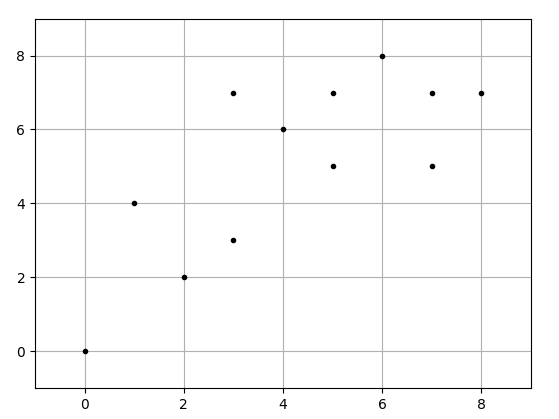
C1 = [1, 4, 5, 9, 11] C2 = list(set(range(12)) - set(C1)) X0C1, X1C1 = X0[C1], X1[C1] X0C2, X1C2 = X0[C2], X1[C2] plt.figure() plt.title(‘第一次叠代後聚類結果‘,fontproperties=font) plt.axis([-1, 9, -1, 9]) plt.grid(True) plt.plot(X0C1, X1C1, ‘rx‘) plt.plot(X0C2, X1C2, ‘g.‘) plt.plot(4,6,‘rx‘,ms=12.0) plt.plot(5,5,‘g.‘,ms=12.0) plt.show()
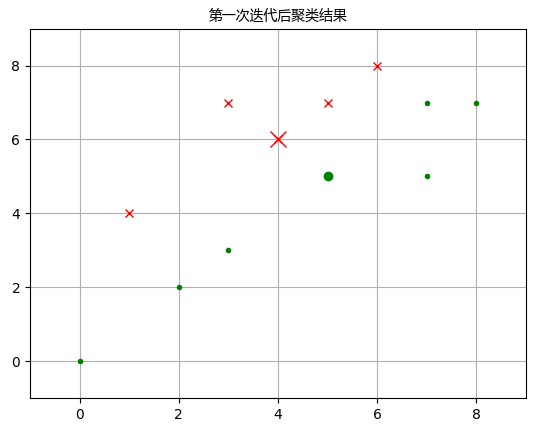
C1 = [1, 2, 4, 8, 9, 11] C2 = list(set(range(12)) - set(C1)) X0C1, X1C1 = X0[C1], X1[C1] X0C2, X1C2 = X0[C2], X1[C2] plt.figure() plt.title(‘第二次叠代後聚類結果‘,fontproperties=font) plt.axis([-1, 9, -1, 9]) plt.grid(True) plt.plot(X0C1, X1C1, ‘rx‘) plt.plot(X0C2, X1C2, ‘g.‘) plt.plot(3.8,6.4,‘rx‘,ms=12.0) plt.plot(4.57,4.14,‘g.‘,ms=12.0) plt.show()
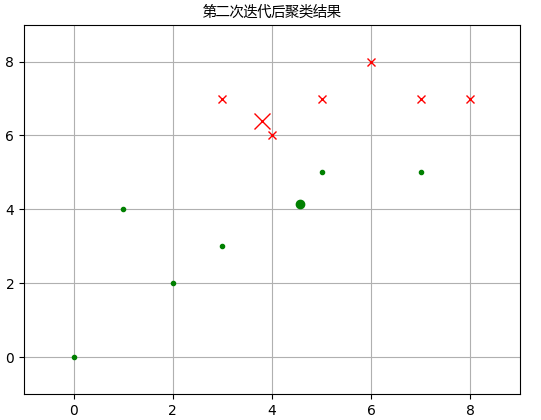
C1 = [0, 1, 2, 4, 8, 9, 10, 11] C2 = list(set(range(12)) - set(C1)) X0C1, X1C1 = X0[C1], X1[C1] X0C2, X1C2 = X0[C2], X1[C2] plt.figure() plt.title(‘第三次叠代後聚類結果‘,fontproperties=font) plt.axis([-1, 9, -1, 9]) plt.grid(True) plt.plot(X0C1, X1C1, ‘rx‘) plt.plot(X0C2, X1C2, ‘g.‘) plt.plot(5.5,7.0,‘rx‘,ms=12.0) plt.plot(2.2,2.8,‘g.‘,ms=12.0) plt.show()
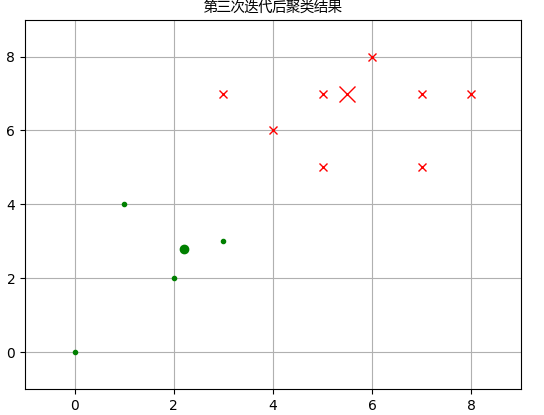
- 局部最優解

- 肘部法則
import numpy as np cluster1 = np.random.uniform(0.5, 1.5, (2, 10)) cluster2 = np.random.uniform(3.5, 4.5, (2, 10)) X = np.hstack((cluster1, cluster2)).T # plt.figure() # plt.axis([0, 5, 0, 5]) # plt.grid(True) # plt.plot(X[:,0],X[:,1],‘k.‘) ‘‘‘計算K值從1到10對應的平均畸變程度:‘‘‘ from sklearn.cluster import KMeans from scipy.spatial.distance import cdist K = range(1, 11) # K = list(range(1, 11)) meandistortions = [] for k in K: kmeans = KMeans(n_clusters=k) kmeans.fit(X) meandistortions.append(sum(np.min(cdist(X,kmeans.cluster_centers_,‘euclidean‘), axis=1)) / X.shape[0]) plt.plot(K, meandistortions, ‘bx-‘) plt.xlabel(‘k‘) plt.ylabel(‘平均畸變程度‘,fontproperties=font) plt.title(‘用肘部法則來確定最佳的K值‘,fontproperties=font) plt.show()
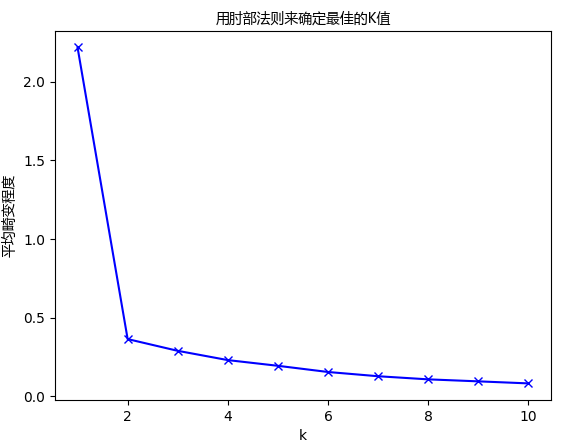
從圖中可以看出,K值從1到2時,平均畸變程度變化最大。超過2以後,平均畸變程度變化顯著降 低。因此肘部就是K=2.
下面用肘部法則來確定3個類的最佳的K值:
import numpy as np x1 = np.array([1, 2, 3, 1, 5, 6, 5, 5, 6, 7, 8, 9, 7, 9]) x2 = np.array([1, 3, 2, 2, 8, 6, 7, 6, 7, 1, 2, 1, 1, 3]) X = np.array(list(zip(x1, x2))).reshape(len(x1), 2) # print(list(zip(x1, x2))) # print(X) plt.figure() plt.axis([0, 10, 0, 10]) plt.grid(True) plt.plot(X[:,0],X[:,1],‘k.‘) plt.show()
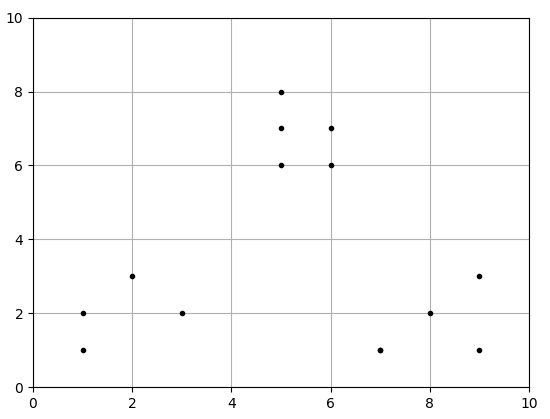
from sklearn.cluster import KMeans from scipy.spatial.distance import cdist K = range(1, 10) meandistortions = [] for k in K: kmeans = KMeans(n_clusters=k) kmeans.fit(X) meandistortions.append(sum(np.min(cdist(X, kmeans.cluster_centers_, ‘euclidean‘), axis=1)) / X.shape[0]) plt.plot(K, meandistortions, ‘bx-‘) plt.xlabel(‘k‘) plt.ylabel(‘平均畸變程度‘,fontproperties=font) plt.title(‘用肘部法則來確定最佳的K值‘,fontproperties=font) plt.show()
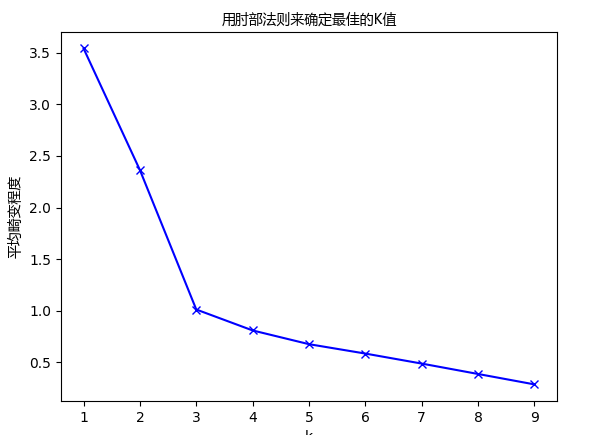
從圖中可以看出, 值從1到3時,平均畸變程度變化最大。超過3以後,平均畸變程度變化顯著降低。因此肘部就是 。
- 聚類效果評估
- 聚類算法效果評估方法稱為輪廓系數(Silhouette Coefficient)
計算公式如下:
a是每一個類中樣本彼此距離的均值,b 是一個類中樣本與其最近的那個類的所有樣本的距離的均 值。下面的例子運行四次K-Means,從一個數據集中分別創建2,3,4,5,8個類,然後分別計算它們 的輪廓系數。
import matplotlib.pyplot as plt from matplotlib.font_manager import FontProperties font = FontProperties(fname=r"C:\Users\Lenovo\Desktop\data_set\msyh.ttc", size=10) import numpy as np from sklearn.cluster import KMeans from sklearn import metrics plt.figure(figsize=(6, 6)) plt.subplot(3, 2, 1) x1 = np.array([1, 2, 3, 1, 5, 6, 5, 5, 6, 7, 8, 9, 7, 9]) x2 = np.array([1, 3, 2, 2, 8, 6, 7, 6, 7, 1, 2, 1, 1, 3]) X = np.array(list(zip(x1, x2))).reshape(len(x1), 2) plt.xlim([0, 10]) plt.ylim([0, 10]) plt.title(‘樣本‘,fontproperties=font) plt.scatter(x1, x2) colors = [‘b‘, ‘g‘, ‘r‘, ‘c‘, ‘m‘, ‘y‘, ‘k‘, ‘b‘] markers = [‘o‘, ‘s‘, ‘D‘, ‘v‘, ‘^‘, ‘p‘, ‘*‘, ‘+‘] tests = [2, 3, 4, 5, 8] subplot_counter = 1 for t in tests: subplot_counter += 1 plt.subplot(3, 2, subplot_counter) kmeans_model = KMeans(n_clusters=t).fit(X) ‘‘‘kmeans_model.labels_獲取索引及對應的類別‘‘‘ for i, l in enumerate(kmeans_model.labels_): plt.tight_layout() #用來調整子圖間距 plt.plot(x1[i], x2[i], color=colors[l], marker=markers[l],ls=‘None‘) plt.xlim([0, 10]) plt.ylim([0, 10]) plt.title(‘K = %s, 輪廓系數 = %.03f‘ % (t, metrics.silhouette_score(X, kmeans_model.labels_, metric=‘euclidean‘)), fontproperties=font) plt.show()
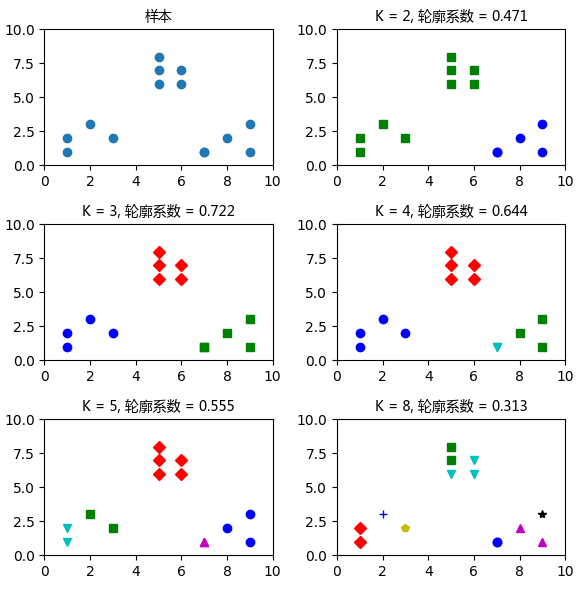
很顯然,這個數據集包括三個類。在K=3 的時候輪廓系數是最大的。在 K=8的時候,每個類的 樣本不僅彼此很接近,而且與其他類的樣本也非常接近,因此這時輪廓系數是最小的。
Re:如果是高維就要通過降維可視化分析
K-Means聚類
